Contents [hide]
Reading
- Evolution Section 18.1 (Openstax CNX)
- Variation under domestication (THE ORIGIN OF SPECIES BY MEANS OF NATURAL SELECTION)
- Variation under nature (THE ORIGIN OF SPECIES BY MEANS OF NATURAL SELECTION)
- Natural Selection (THE ORIGIN OF SPECIES BY MEANS OF NATURAL SELECTION)
Learning Objectives
- Explain the revolutionary aspects of Darwin’s and Wallace’s evolutionary concepts.
- Understand why natural selection is the driving force for evolution.
- Know the experimental evidence that supports the evolution of carbon based life on earth.
- Understand the importance of the early cyanobacteria.
- Name (a) the three characteristics that distinguish a cell from a mere aggregation of molecules and (b) the two main characteristics that make Earth so hospitable to life.
- Explain the process of continental drift and plate tectonics.
- Describe the geological eras of the earth and name the dominant group(s) of animals and plants in each.
Taxonomy: Animal, vegetable or mineral?
 Science requires a language of it’s own to differentiate from colloquial language. In order to study life, scientists must utilize a common precise language to describe organisms. The Swedish physician and scientist Carl von Linné developed a systematic hierarchy to organize life and binomial nomenclature to precisely name organisms in his publication Systema Naturae. Linné’s binomial nomenclature named individual species of organisms using two-part Latin names consisting of a genus and species (Homo sapiens). Inspired by this system, he applied this to himself and wrote under the Latinized name Carolus Linnæus. A species name must be written as capital Genus and lower case species in italics or underlined to properly illustrate a species name.
Science requires a language of it’s own to differentiate from colloquial language. In order to study life, scientists must utilize a common precise language to describe organisms. The Swedish physician and scientist Carl von Linné developed a systematic hierarchy to organize life and binomial nomenclature to precisely name organisms in his publication Systema Naturae. Linné’s binomial nomenclature named individual species of organisms using two-part Latin names consisting of a genus and species (Homo sapiens). Inspired by this system, he applied this to himself and wrote under the Latinized name Carolus Linnæus. A species name must be written as capital Genus and lower case species in italics or underlined to properly illustrate a species name.
Carolus Linnæus was not the first to use a binomial system, but he used it consistently across Systema Naturae and is known as the father of taxonomy for organizing life into a nested hierarchy of relatedness. Modern taxonomy classifies organisms from broadest to most specific: Domain, Kingdom, Phylum, Class, Order, Family, Genus, Species. These divisions can further be divided by using the prefix super- and sub-.

Hierarchical classification of a Red fox. Credit: [CC-BY-SA 4.0]
Disambiguation
The precision of binomial nomenclature allows a common language to name organisms without ambiguity of vernacular or regional language. In the US, the word buzzard denotes a carrion consuming bird like a vulture. However, in the UK, buzzard describes an active hunting bird.
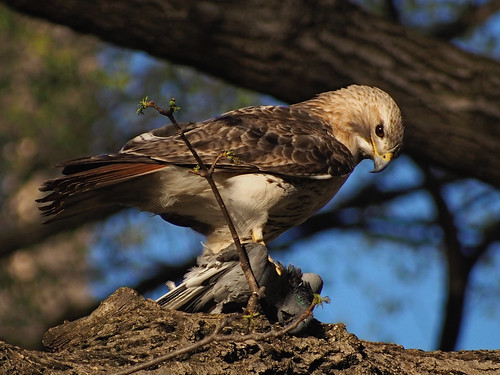
Pale Male, a red-tailed hawk (Buteo jamaicensis). In the United States he is identified as a hawk. In the United Kingdom he is identified as a buzzard. Credit: Jeremy Seto [CC-BY-NC-SA]
Relationship of all life
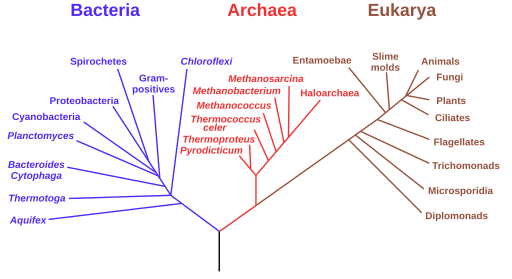
Phylogenetic tree of life illustrates the relatedness of organisms and the broad categorization into three domains of life: Bacteria, Archaea and Eukaryota.
All life on earth follow the same basic instruction sets and are utilize chemical information transfer in a similar fashion. Three domains exist: Archaea, Bacteria and Eukarya. Archaea and Bacteria are also grouped together as Prokaryotes (pro– before; karya– nucleus). Eukarya (eu– true; karya– nucleus), or eukaryotes, is a group of of organisms that have nuclei. The second most inclusive or broad category is Kingdom. Humans are in the Kingdom of animals. The third most inclusive or broad category is Phylum. Humans are in the phylum called chordata. Each level of organization can be further subdivided and you may be more familiar with the subphylum called vertebrata. Within the this division, humans fall in the class of mammals. Amongst the mammals, humans are in the order of primates. Humans are categorized into a narrower group of organisms in the family of great apes or hominids. Within this family, humans fall into the genus of Homo. Biologists use a method of identifying specific organisms called binomial nomenclature. Binomial nomenclature uses the most specific groupings of taxonomy (genus and species) as a two part name. While humans are of the species sapiens, the species name of humans using binomial nomenclature is Homo sapiens.
Geologic Time Scale
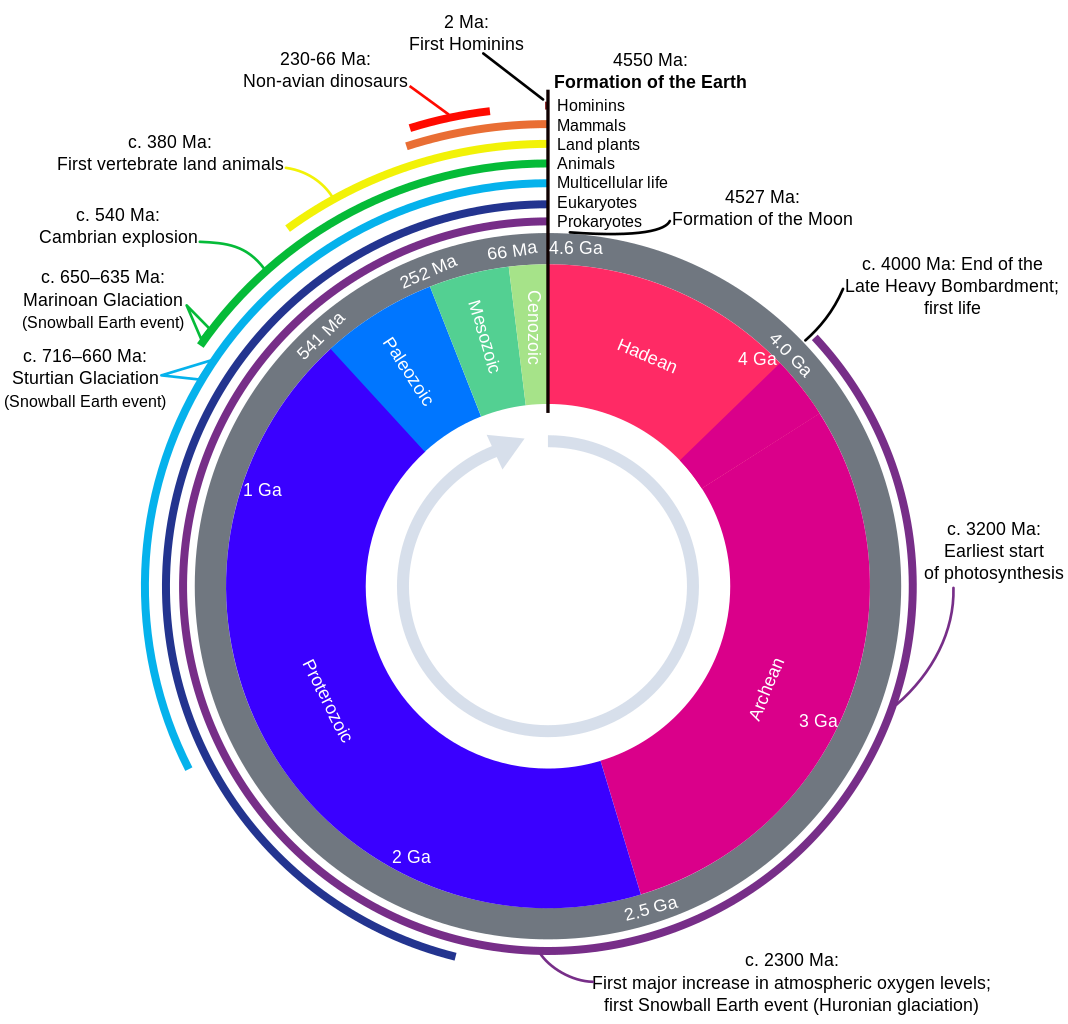
The age of the Earth is 4.54 Billion years old. This number was determined by radiometric dating terrestrial and lunar samples with additional calibration to meteorites. With this large number of years in mind, there was ample time for historic changes to occur on the planet that encompass geologic, climate and organismal population shifts. One major climate changing shift occurred about 4 Billion years ago as atmospheric oxygen began to accumulate due to the first photoautotrophs. Comparing the geologic time scale to a 24-hour clock, modern humans only arrived on this planet at 4 seconds to midnight.
Lamarck’s Use and Disuse
The French biologist, Jean Baptiste-Lamarck, discussed the occurrence of different organisms with two forces governing evolution: adaptive and complexifying forces. The complexifying force drives body plans towards the higher taxa while the adaptive force caused organisms to adapt to their circumstances. These discussions in the early 1800s involved two major ideas: use/disuse and inheritance of acquired traits.
 His idea of use versus disuse is exemplified by the case of giraffes. It was thought that giraffes descended from an antelope. As giraffes would reach higher towards trees to acquire leaves, they would stretch their necks through successive generations and inherit gradually longer necks.
His idea of use versus disuse is exemplified by the case of giraffes. It was thought that giraffes descended from an antelope. As giraffes would reach higher towards trees to acquire leaves, they would stretch their necks through successive generations and inherit gradually longer necks.
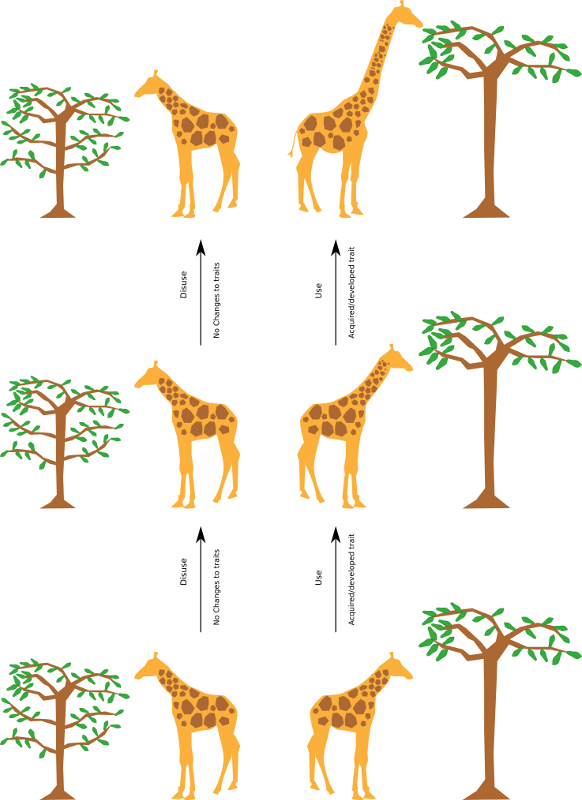 At the end of the 19th century, the evolutionary biologist, August Weismann tested the ideas of use/disuse and acquired inheritance of traits. Weismann took 68 mice and cut their tails off. After mutilation, the mice were permitted to breed. He repeated the amputation of tails and breeding for 5 generations. If the unused tails were acquired as a trait, then one would think that the tail length over multiple generations would progressively shrink. Weismann found that no shortening of tails occurred, thereby excluding Lamarck’s tenets of inheritance of acquired traits from use or disuse.
At the end of the 19th century, the evolutionary biologist, August Weismann tested the ideas of use/disuse and acquired inheritance of traits. Weismann took 68 mice and cut their tails off. After mutilation, the mice were permitted to breed. He repeated the amputation of tails and breeding for 5 generations. If the unused tails were acquired as a trait, then one would think that the tail length over multiple generations would progressively shrink. Weismann found that no shortening of tails occurred, thereby excluding Lamarck’s tenets of inheritance of acquired traits from use or disuse.
Darwin and the Voyage of the Beagle

Darwin’s voyage on the HMS Beagle. Credit: Semhur,Kipala, Samsara and Dave souza [CC-BY-SA 4.0]
Variation

Variation of cats due to domestication and artificial selection of desirable traits. Credit: Alvesgaspar [CC-BY-SA 3.0]
One major aspect of natural selection surrounds the natural diversity that exist within organisms of a species. It is these variations that illustrate the natural starting point for adaptation to specific environments and ecosystems. Darwin observed that organisms often reproduced at a rate greater than the environment could handle and that the individuals who survived to reproduce again were often had features that were best suited for that ecosystem.

Arctic hares have adaptations for its environment: short ears for heat conservation, large paws for walking on snow, seasonal molting for camouflage. In summer, the fur molts and a coat of brown grows in. In winter, a white coat grows in. These features come in a spectrum of variations of sizes and colors. Over many generations, these features have become more stabilized with a narrower range of variation that is suited for the arctic environment. Credit: Steve Sayles [CC-BY-SA 2.0]
Fossils
The French anatomist/zoologist Georges Cuvier, established the fields of paleontology and comparative anatomy in the early 1800s. He was a staunch creationist who opposed the idea of evolution. Cuvier proposed the idea of catastrophism where multiple cycles of creation that gave rise to the diversity of fossils that emerged from multiple catastrophes, like the flood of the Old Testament. Darwin observed that the great age of the Earth (4.5 billion versus 6,000 years) permitted enough time to explain the gradual changes found in fossils at various depths of sediment.
Darwin’s understanding of geologic time was coupled by a number of other evidence. Contrary to Cuvier’s catastrophism, the fossil evidence showed new species appearing gradually and while populations of species had changed, the rates of changes were unequal between different species. Darwin also understood an aspect of heritability as fossils had illustrated that there were no reappearances of species following extinction. The gradual changes often spoke to descent with modification as opposed to catastrophic events.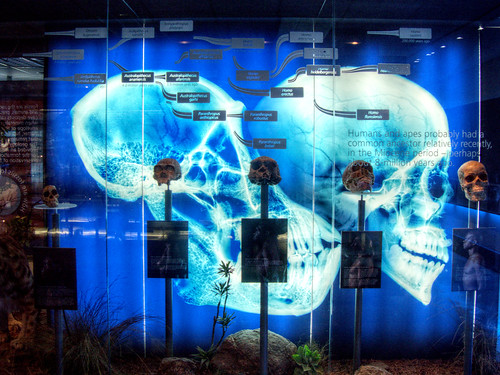
Progression of transitional changes in morphology over time. An image taken in a museum at the Cradle of Humankind, a world heritage site and active paleontological site. Credit: Jeremy Seto [CC-BY-NC-SA]

A human coprolite (fossilized feces) informs archaeologists and paleontologists of associated flora and fauna that reveal evidence of geologic time. Coprolites can even preserve DNA that can now be analyzed and provide genetic information to scientists. This coprolite yields evidence of health and diet based on pollen granules and presence of parasitic worms. Credit: Storye book [CC-BY 2.5]
Anatomy & Embryology
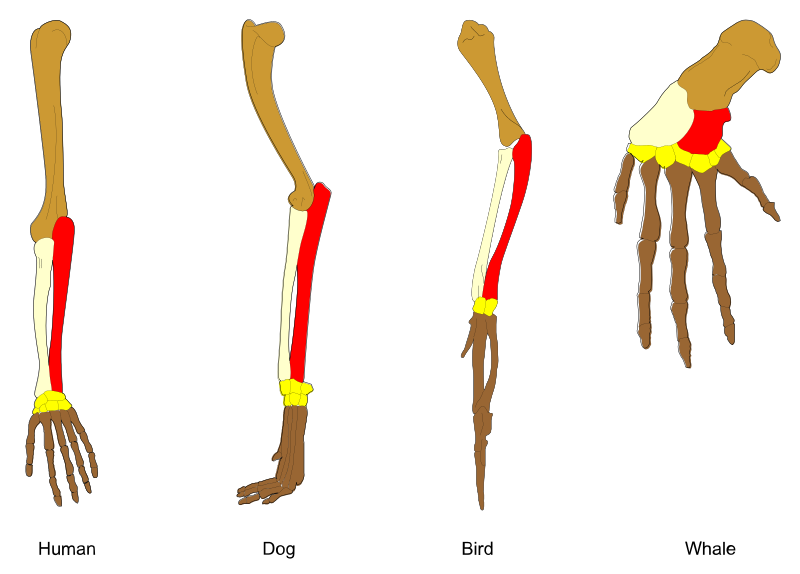
Homologous anatomical parts. Credit: Волков Владислав Петрович [CC BY-SA 4.0]

Adaptations to homologous part suited for differing ecological niches. Credit: Jerry Crimson Mann [CC-BY-SA 3.0]
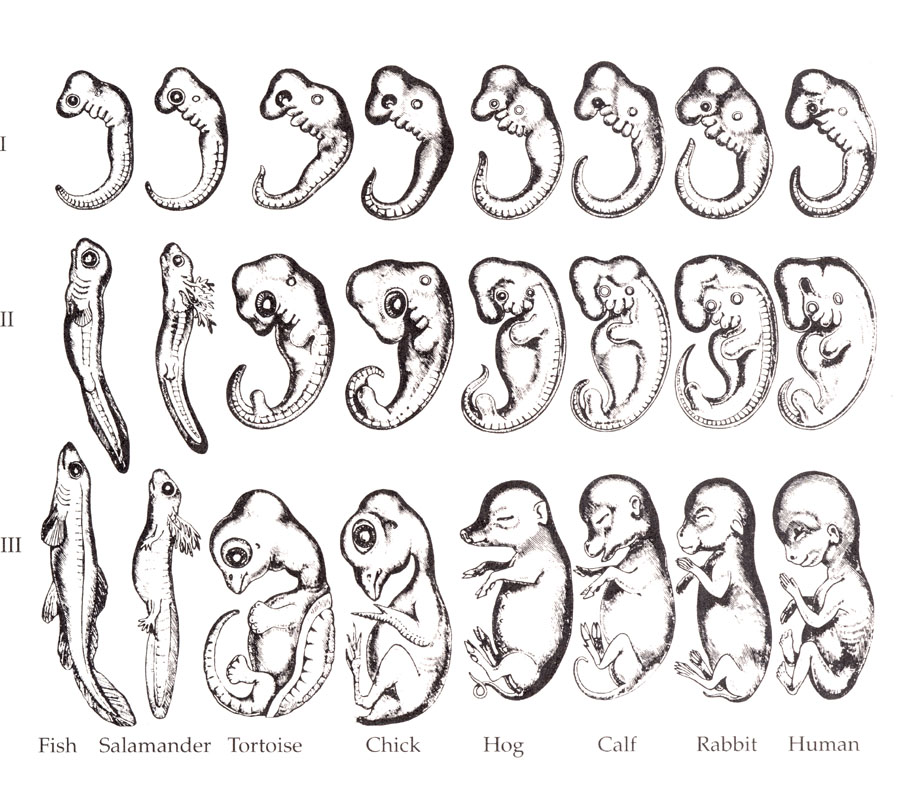
“Ontogeny recapitulates phylogeny”. Organisms sharing common ancestry reveal developmental structures. Credit: Romanes, G. J.; Phlebas; SeventyThree [Public domain]
Biogeography

Distribution and isolation of Galapagos tortoises. Credit: Fallschirmjäger [CC BY-SA 4.0]

Diversity of tortoises found in the Galapagos archipelago. Credit: Minglex, Mikko Koponen , Mark Putney, Mike Weston, Jeremy Seto [CC-BY-SA]
Darwin also observed the diversity in finches on the islands. These finches would be revisited in the 1970s by the ecologists Peter and Rosemary Grant who performed measurements on finches of the island of Daphne Major that would reveal that rapid evolution could occur in relatively small windows of time based on the changes to environmental conditions.
 The Video below illustrates the the combination of evidence collected by the Grants and others to describe the phenomena surrounding natural selection in driving the evolution of the diverse finch species.
The Video below illustrates the the combination of evidence collected by the Grants and others to describe the phenomena surrounding natural selection in driving the evolution of the diverse finch species.Molecular Biology
Advances in DNA technology has provided an era of genomics where whole genomes (the entirety of the DNA that makes up an organism) are sequenced. Not all genomes are sequenced, but pieces of DNA that are commonly shared between organisms can be used as molecular markers of relatedness. Furthermore, the genetic information encoded in the DNA of an organism reveals the programs that give rise to embryogenesis and development when ontogeny may recapitulate phylogeny/

An alignment of part of the cytochrome oxidase I gene between different mammals. The sequence data can be used to generate trees of relatedness. Credit: Jeremy Seto [CC-BY-NC-SA]
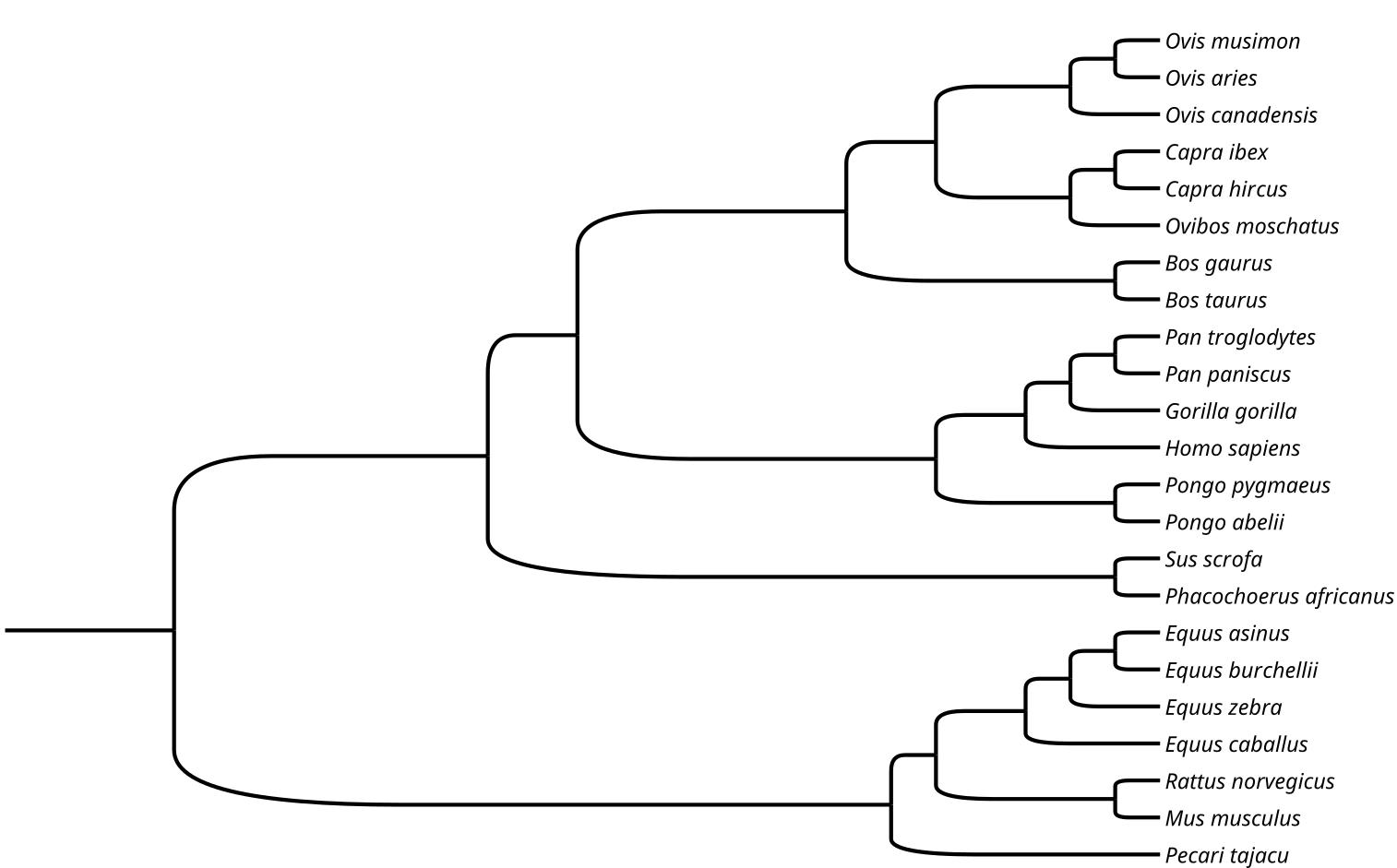
Tree derived from the alignment of part of the cytochrome oxidase I gene from different mammals. A more accurate tree can be created by including additional genes. Credit: Jeremy Seto [CC-BY-NC-SA]
Protein sequences can also be used for more distantly related organisms. However, there exists less protein sequence data.

Alignment of organisms from different classes illustrate the similarity in closely related organisms. Credit: Jeremy Seto [CC-BY-NC-SA]

An unrooted tree of the myoglobin protein sequence alignment illustrating the natural clustering of closely related species as indicated by their class. Credit: Jeremy Seto [CC-BY-NC-SA]
Bacterial Evolution: Antibiotic Resistance
Antibiotic resistance illustrates the rapidity of evolution in human time. Bacteria can reproduce very rapidly (every 15-20 minutes at 37°C for E. coli) with respect to human time. Because of this, large numbers of bacterial generations may arise in a relative short amount of time.






